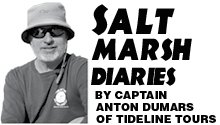Man Creates Order, Nature Creates Perfection
 Daylight savings time makes early-morning moon viewing easier. At 6 a.m., darkness vails the landscape. In contrast to the darkness, the yet-to-rise sun lights up the left half of the moon.
Daylight savings time makes early-morning moon viewing easier. At 6 a.m., darkness vails the landscape. In contrast to the darkness, the yet-to-rise sun lights up the left half of the moon.
The moon orbits the earth every 27.3 days. Yet it takes 29.5 days from one new moon to the next. While the moon orbits the earth, the earth advances along its orbital arc around the sun. By the time the moon catches up with the earth to form a new moon, an additional 2.2 days have past. Such is the interplay of celestial bodies in motion.
Our moon, as the closest large gravitational body to the earth, affects our tidal range more than any other external force. The sun plays a smaller roll due to distance from earth. Other variables, specifically eccentricities of orbital paths (earth around sun/ moon around earth), also influence our tidal range (i.e. — eccentricities such as how circular or elliptical the orbit, which change over time). The common variable is distance from one gravitational body to the next, which is squared in the gravity equation: ((Gravity (mass1 x mass2))/distance^2).
In essence, because of this gravitational pull of the moon, a moon-gravity induced egg-shaped bulge of ocean stays in place as the earth rotates under it. As a result, twice a day, the Stono Inlet scoops up a mouthful of Atlantic, then later spits it back out. Currents move one way for a while, then they move the other way. Underwater sand waves do likewise, creating telltale bed forms known as herringbone cross beds. In the rock record, sandstone found with herringbone cross bed structures indicate bi-directional current flow, most likely the result of tidal currents.
By 7 a.m., the morning twilight chased the last stars from the sky. A cold north wind shutters through the oak leaves overhead. The old white dog and younger black dog find their respective spots near the wooden fence.
A fence, built from reclaimed siding, is one only a geologist could truly appreciate; a perfectly horizontal center separates the upper and lower opposing diagonal sections. Opposing diagonals, set at a respectable 30-degree angle of repose, represent herringbone cross beds. Unlike the natural variability found in real herringbone cross beds, those on the fence seem too orderly. Tape measures and levels create order. Nature creates perfection.
Anton DuMars, a coastal geologist and longtime beach observer, collects sand as a hobby. Coming soon: Spartina Sailing Adventures. Contact Anton at: sailspartina@gmail.com.

